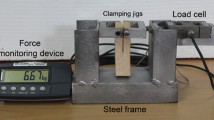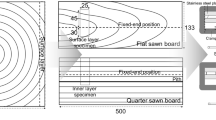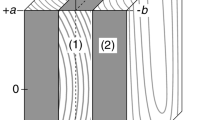Abstract
Timber changes its shape at varying moisture content levels. In most pieces of timber, this causes distortion, such as twist, spring, bow and cup. Twist is one of the most severe distortion modes and is reversible at varying moisture contents. Restraining a stud from twisting in built-in conditions results in additional forces in the structure. This paper presents a method for measuring the torsional moment while restraining the twist during drying in in-service conditions. The results include the development of torsional moment and the moisture content versus time, as well as the final torsional moment and the corresponding free twist. The magnitude of the torsional moment in studs results in forces affecting the surrounding structure which can then be restrained in an appropriate manner by fasteners. The development of torsional moment versus time demonstrates the importance of controlling the moisture content and the importance of a rapid building process when there is a risk of fast drying. The measured torsional moment was correlated to several measured material properties. However, a good correlation was only found between torsional moment and free twist.
Zusammenfassung
Holzfeuchteänderungen führen bei Holz zu Formänderungen wie zum Beispiel Verdrehung, Längs- und Querkrümmung sowie Schüsselung. Eine der schlimmsten Verformungen ist die Verdrehung, die bei wechselnder Holzfeuchte reversibel ist. Das Geradebiegen verdrehter Holzständer beim Einbau führt zu einer zusätzlichen Beanspruchung der Konstruktion. In diesem Manuskript wird eine Methode vorgestellt, zur Messung des Torsionsmoments infolge einer behinderten Verdrehung während der Trocknung unter Praxisbedingungen. Die Ergebnisse beinhalten den zeitlichen Verlauf des Torsionsmoments und der Holzfeuchte als auch das maximale Torsionsmoment und die entsprechende unbehinderte Verdrehung. Das Torsionsmoment in den Holzständern führt zu Kräften, die auf die umgebende Konstruktion wirken, und die dann in geeigneter Form über Verbindungsmitteln aufgenommen werden können. Der zeitliche Verlauf des Torsionsmoments zeigt, wie wichtig es ist, die Holzfeuchte zu kontrollieren und das Holz schnell zu verarbeiten, wenn eine schnelle Trocknung zu befürchten ist. Das gemessene Torsionsmoment wurde mit verschiedenen gemessenen Materialeigenschaften korreliert. Eine gute Korrelation ergab sich jedoch nur zwischen Torsionsmoment und unbehinderter Verdrehung.
Similar content being viewed by others
References
Bäckström M, Johansson M, Kliger R (2004) Properties of timber converted by using novel techniques. Report on WP 5 STRAIGHT Project. Structural Engineering Mechanics – Steel and Timber Structures
Danborg F (1994) Drying Properties and Visual Grading of Juvenile Wood from Fast Grown Picea-Abies and Picea-Sitchensis. Scand J Forest Res 9(1):91–98
Johansson M, Perstorper M, Kliger R, Johansson R (2001) Distortion of Norway spruce timber – Part 2. Modelling twist. Holz Roh- Werkst 59:155–162
Kliger R, Johansson M, Perstorper M, Johansson G (2003) Distortion of Norway spruce – Part 3. Modelling bow and spring. Holz Roh- Werkst 61:241–250
Mackay JFG (1973) The influence of drying conditions and other factors on twist and torque in Pinus Radiata studs. Wood Fiber Sci 4(47):264–271
Northway RL (1981) Restraint forces needed to hold Radiata pine heart-in studs straight during high temperature drying. In: Proceedings of Forest Products Research Conference, CSIRO, Melbourne, Australia
Ormarsson S (1999) Numerical analysis of moisture related distortion in sawn timber. Doctoral thesis, Department of Structural Engineering, Chalmers University of Technology, Göteborg, Sweden
Perstorper M (1999) Dynamic testing of logs for prediction of timber strength. In: Proceedings of the Pacific Timber Engineering Conference, PTEC’99, Rotorua, New Zealand
Perstorper M, Johansson M, Kliger R, Johansson G (2001) Distortion of Norway spruce timber – Part 1. Variation of relevant wood properties. Holz Roh- Werkst 59:94–103
Salin JG (2004) STRAIGHT – Report on results obtained within Workpackages 2.4 and 2.7 Laboratory tests. SP-Trätek internal report, Stockholm, pp 1–32
Shmulsky R, Erickson RW (2004) Twist assessment and reduction in southern pine 2 by 4’s. Forest Prod J 54(4):66–68
Author information
Authors and Affiliations
Corresponding author
Rights and permissions
About this article
Cite this article
Bäckström, M., Kliger, R. Restraining moisture-related twist in timber structures. Holz Roh Werkst 64, 235–242 (2006). https://doi.org/10.1007/s00107-005-0059-7
Published:
Issue Date:
DOI: https://doi.org/10.1007/s00107-005-0059-7




